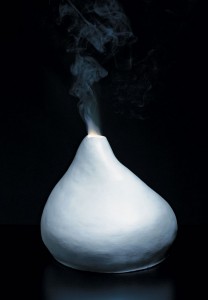Coloring our world, artists turn increasingly to shades of green
By Beth Farnstrom

"Sun, Moon, Star" features "OMPHALOS," a stoneware sculpture which burns incense to project a wavering image of the full moon onto a painting of stars suspended from the ceiling.
Living close to the earth didn’t always signify being hip, modern, and eco-friendly. Bugs live close to the earth. In earlier times, serfs wearing rough-sewn smocks colored with bilious vegetable dye lived barely a notch above it, on straw pallets. Today, eco is chic. There are vegan suede stilettos for sale; Salma Hayek and Cameron Diaz zip around the Hills in sexy little hybrid roadsters. These, however, are the habits of a telegenic few, and can’t really be expected to completely pervade the shopping habits of WalMart moms and Home Depot dads. Or even artists, to bring this column back to the point. What’s the state, then, of eco-art?
Pigment was once as precious (and as symbolic) as gold. Specific tinctures of lapis added value to papal commissions; painting could be a literal “show” of status. Making artwork, then, with twigs and cow urine, wouldn’t signify “environmentally conscious” or “close to the earth, spiritually” as much as “crazy peasant.” In our century, Italian art critic Germano Celant introduced the term “Arte Povera,” or “poor art,” to describe the work of artists like Domenico de Clario and Alighiero e Boetti, who used sticks, rocks, slate, rope, iron, and other “common” materials. The draw in 1960s Genoa and Rome was more likely political – common art for the common man – but it certainly paved the way for artists who use natural materials today.
